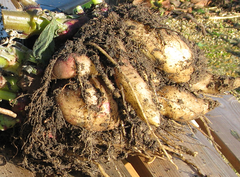Total phenolic content and antioxidant activity of yacon (Smallanthus sonchifolius poepp. and endl.) chips: Effect of cultivar, pre-treatment and drying [11.12.18]
Original publication
Khajehei, Forough; Hartung, Jens; Graeff-Hönninger, Simone (2018): Total phenolic content and antioxidant activity of yacon (Smallanthus sonchifolius poepp. and endl.) chips: Effect of cultivar, pre-treatment and drying. In: Agriculture (Switzerland) 8 (12). DOI: 10.3390/agriculture8120183.
Author Informationen:
- Institute of Crop Science, University of Hohenheim, Fruwirthstr. 23, Stuttgart, 70599, Germany
- Department of Biostatistics, Institute of Crop Science, University of Hohenheim, Fruwirthstr. 23, Stuttgart, 70599, Germany
Abstract
Recent studies have associated the consumption of yacon root as a functional plant food with reduced glycemic index and, due to its considerable phenolic acid levels, a protection of cell membranes against free radical damage. This study examined the effect of four different treatments including: (1) storage duration after harvest (one and three weeks after harvest); (2) pre-treatment before drying (untreated, pre-treatment with diluted lime juice); (3) drying method (freeze drying (FD) and convective hot air drying (CHAD)); and (4) cultivar (white and red), on the quality of yacon (Smallanthus sonchifolius Poepp. and Endl.) chips in terms of their total phenolic content (TPC) and antioxidant activity (AA) (ABTS (2,2′-Azino-Bis (3-Ethylbenzothiazoline-6-Sulfonic Acid) Diammonium Salt) radical scavenging activity, DPPH (2,2-diphenyl-1-picrylhydrazyl) radical scavenging activity and ferric reducing antioxidant power (FRAP)). Overall, the chips that were produced using pre-treatment with diluted lime juice and FD had the highest amounts of TPC and AA. Regarding the chips produced by means of CHAD, retention of higher TPC and AA was possible with lime-juice pre-treatment and use of higher hot air temperatures. Moreover, chips produced from the white cultivar had higher TPC and AA than chips produced from the red cultivar. © 2018 by the authors. Licensee MDPI, Basel, Switzerland.


